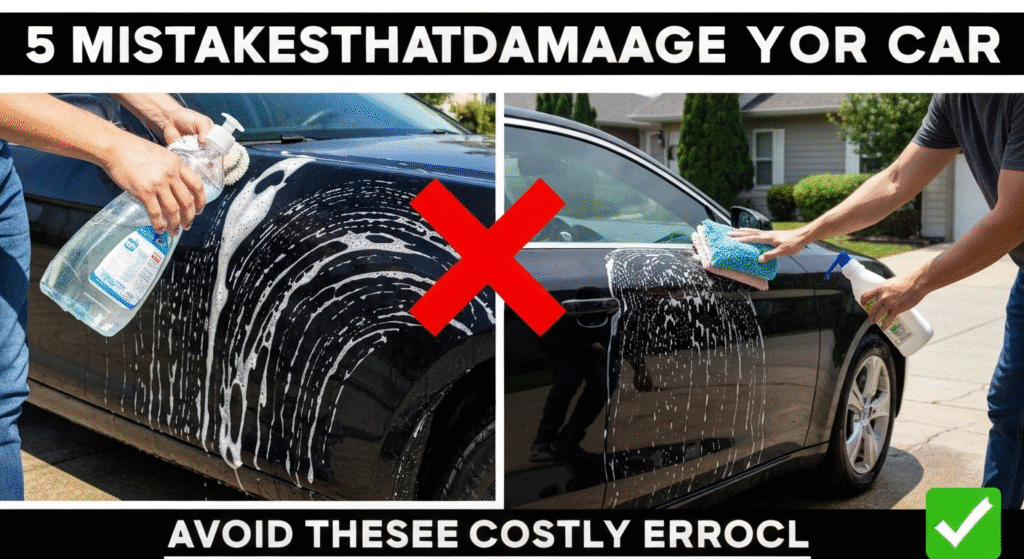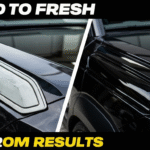Car washing mistakes can cost you hundreds of dollars in paint damage, scratches, and long-term vehicle deterioration. After five years of professional detailing experience, I’ve seen countless cars arrive at my shop with avoidable damage from improper washing techniques. These mistakes happen more often than you’d think, and they’re easier to prevent than repair.
Hi, I’m Sharmin, and I’ve spent the last five years as a professional automotive detailer working with luxury vehicles, daily drivers, and everything in between. During this time, I’ve restored paint jobs damaged by common washing errors and taught hundreds of car owners the proper techniques. My expertise comes from hands-on experience with thousands of vehicles, advanced training in paint correction, and continuous learning about automotive care products and methods.
This guide covers the five most damaging car washing mistakes I encounter regularly. You’ll learn why these errors happen, how to spot them, and most importantly, how to avoid them completely. By the end, you’ll have the knowledge to wash your car safely and maintain its value for years to come.
Understanding the Basics of Safe Car Washing
Before diving into specific mistakes, let’s establish what proper car washing involves. Safe car washing protects your vehicle’s paint, glass, and trim while removing dirt, grime, and contaminants effectively.
Your car’s paint has multiple layers. The clear coat sits on top, protecting the colored paint underneath. This clear coat can scratch easily if you use the wrong techniques or tools. Once damaged, it’s expensive to repair and significantly affects your car’s appearance and resale value.
The key principles include using the right products, following proper sequences, and choosing appropriate tools. Temperature, timing, and technique all play crucial roles. When you understand these fundamentals, avoiding costly mistakes becomes much easier.
Mistake #1: Using Household Cleaners and Detergents
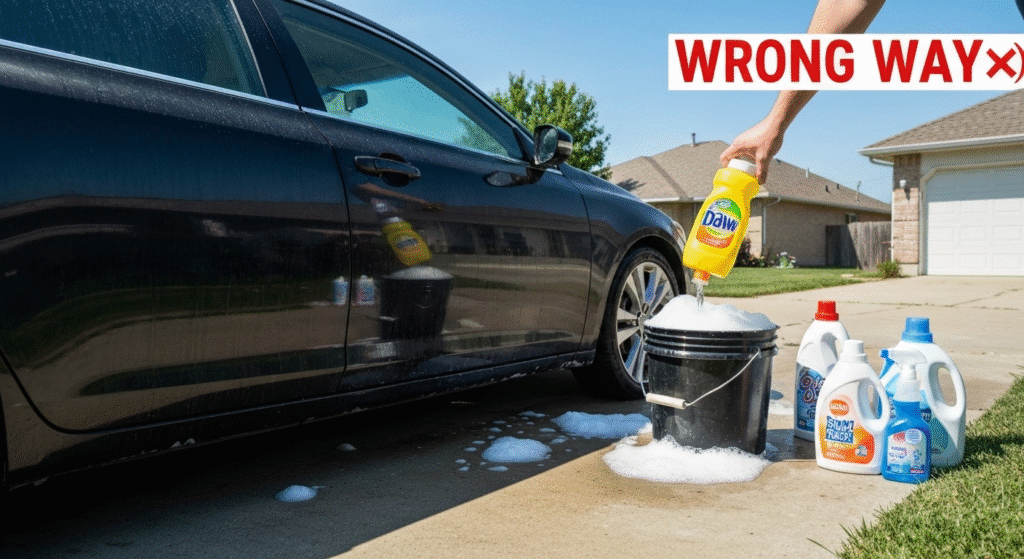
One of the most damaging mistakes involves using dish soap, laundry detergent, or other household cleaners on your car. These products seem logical since they clean effectively, but they’re formulated for different purposes and can seriously harm your vehicle.
Why Household Cleaners Damage Cars
Dish soap strips away protective waxes and sealants that shield your paint from environmental damage. It’s designed to cut through grease on dishes, which means it removes the protective oils and coatings on your car too aggressively. This leaves your paint vulnerable to oxidation, fading, and contamination.
Laundry detergents contain brightening agents and harsh chemicals that can discolor trim pieces and damage rubber seals. I’ve seen cars with faded plastic trim and cracked weather stripping directly linked to using inappropriate cleaning products.
The Right Products to Use
Automotive-specific car shampoos are pH-balanced for vehicle surfaces. They clean effectively while preserving protective coatings. Quality car shampoos contain lubricating agents that help your wash mitt glide safely across the paint.
| Product Type | pH Level | Effect on Paint | Cost Range |
|---|---|---|---|
| Dish Soap | 7-9 | Strips protection | $2-5 |
| Car Shampoo | 6-7 | Preserves coatings | $8-25 |
| Laundry Detergent | 8-10 | Can discolor trim | $3-8 |
Look for car shampoos labeled as “pH neutral” or “paint-safe.” Popular brands include Chemical Guys, Meguiar’s, and Mother’s. These products cost slightly more than household cleaners but prevent expensive damage.
Real-World Example
Last year, a client brought me a two-year-old BMW that looked ten years old. The owner had been washing it weekly with dish soap for eighteen months. The black paint had turned gray in spots, and all the trim pieces were faded. The repair cost exceeded $1,200, far more than quality car care products would have cost.
Mistake #2: Washing in Direct Sunlight
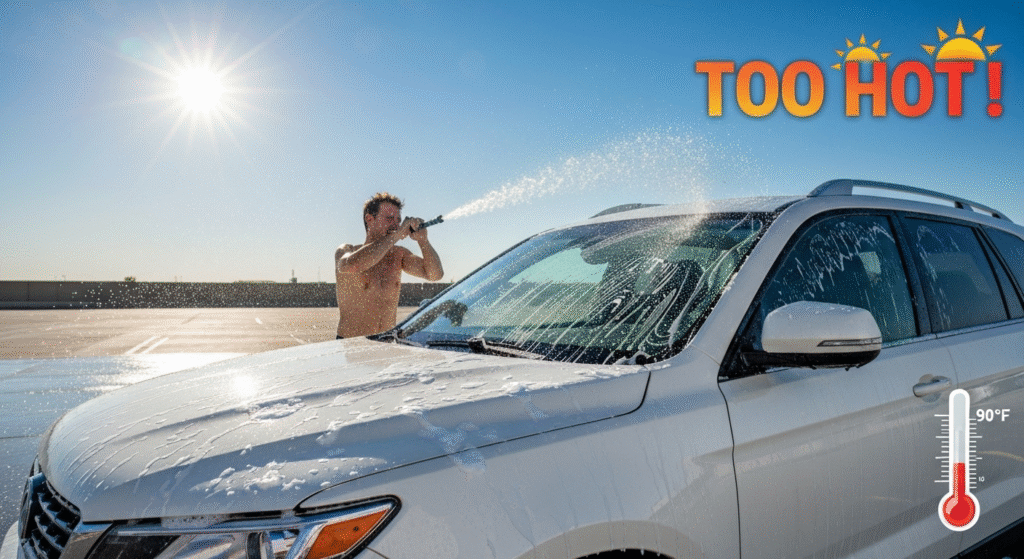
Washing your car in bright sunlight or on hot surfaces creates multiple problems that can permanently damage your paint and leave unsightly water spots.
The Science Behind Sun Damage
When you wash a hot car, water and soap dry too quickly. This rapid drying creates water spots that etch into the clear coat. These spots aren’t just surface dirt you can wipe away they’re actually microscopic craters in your paint’s protective layer.
Hot surfaces also make soap less effective. The cleaning agents don’t have enough time to break down dirt and grime before evaporating. This means you end up scrubbing harder, which increases scratch risk.
Temperature and Timing Guidelines
The ideal washing temperature for your car’s surface is between 60-80°F. Touch the hood before starting if it’s too hot to keep your hand on comfortably, wait for it to cool down.
Best washing times:
- Early morning (6-9 AM)
- Late afternoon/evening (after 4 PM)
- Overcast days
- Shaded areas anytime
Pros and Cons of Different Washing Conditions
Washing in Shade:
- Pros: Prevents water spots, soap works effectively, comfortable working conditions
- Cons: May need artificial lighting for thorough inspection
Washing in Direct Sun:
- Pros: Good visibility, faster drying for some steps
- Cons: Water spots, soap dries too quickly, uncomfortable heat, increased scratch risk
Washing in Cool Weather:
- Pros: No water spot concerns, soap stays active longer
- Cons: Water may freeze, uncomfortable conditions, longer drying times
Professional Tip
If you must wash in warm conditions, work in small sections. Wet a panel, wash it, and rinse immediately before moving to the next area. This prevents soap from drying on the surface.
Mistake #3: Using the Wrong Washing Tools
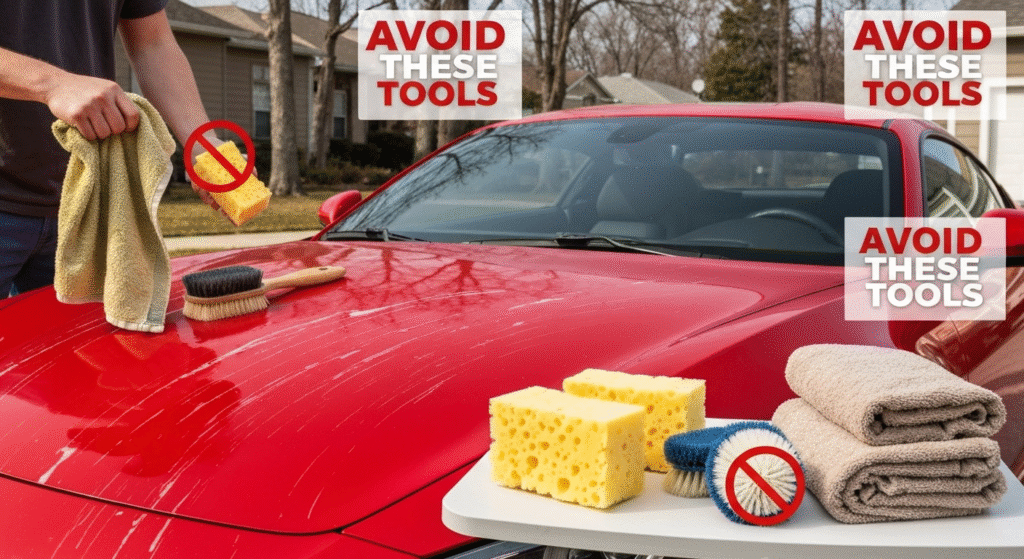
The tools you choose can make the difference between a safe wash and a paint-damaging disaster. Many car owners unknowingly use abrasive materials that create thousands of tiny scratches with each wash.
Dangerous Tools to Avoid
Terry cloth towels might seem soft, but they can trap dirt particles and drag them across your paint. Old t-shirts and rags often have rough seams or have accumulated lint that scratches surfaces.
Brush attachments for pressure washers sound convenient, but most are too stiff for automotive paint. Even “soft” bristles can create swirl marks, especially when dirt gets trapped between the bristles.
Sponges are particularly problematic. They don’t release dirt and grime effectively, so you end up grinding contaminants into your paint with each pass.
Safe Washing Tools
Microfiber wash mitts are the gold standard for safe car washing. They have deep fibers that trap dirt away from the paint surface. When dirt does get trapped, the mitt releases it easily when rinsed.
Natural sea sponges work well too, but quality varies significantly. Look for genuine sea sponges with fine, consistent pores.
Foam cannons or foam guns help pre-treat surfaces with thick, clinging soap that loosens dirt before you make physical contact with the paint.
| Tool Type | Safety Rating | Dirt Release | Durability | Cost |
|---|---|---|---|---|
| Microfiber Mitt | Excellent | Excellent | Good | $8-15 |
| Sea Sponge | Good | Good | Fair | $12-25 |
| Terry Towel | Poor | Poor | Fair | $3-8 |
| Old T-Shirt | Very Poor | Very Poor | Poor | Free |
Proper Tool Maintenance
Clean washing tools properly to maintain their effectiveness. Rinse mitts and sponges thoroughly during washing to remove trapped dirt. After washing, clean microfiber tools with dedicated microfiber detergent avoid fabric softeners, which reduce their cleaning ability.
Replace washing tools regularly. Even the best microfiber mitt will accumulate wear over time. When you notice reduced dirt release or increased surface friction, it’s time for replacement.
Mistake #4: Improper Rinsing and Drying Techniques
How you rinse and dry your car affects the final results dramatically. Poor techniques can leave water spots, streaks, and even scratches on freshly washed surfaces.
Rinsing Mistakes
Many people rinse with a standard hose nozzle set to a narrow, high-pressure stream. This approach doesn’t remove soap effectively and can drive dirt particles across the paint surface.
Inadequate rinsing leaves soap residue that dries into streaks and spots. Even worse, soap residue attracts dirt, making your car look dirty faster.
Starting the rinse from the bottom up is another common error. This approach spreads dirt from lower panels across clean upper surfaces.
Proper Rinsing Technique
Use a wide, gentle spray pattern that covers large areas efficiently. Start rinsing from the top and work downward, letting gravity help remove soap and dirt.
Rinse each section thoroughly before the soap dries. In warm weather, you might need to rinse panels multiple times during the washing process.
Final rinse should be comprehensive and methodical. Take your time to ensure all soap residue is removed from every surface, including door jambs, wheel wells, and trim pieces.
Drying Problems and Solutions
Air drying might seem gentle, but it often leaves water spots, especially in areas with hard water. Chamois cloths were once popular, but they can scratch if not perfectly clean.
The safest drying method uses clean, plush microfiber drying towels. These towels absorb water quickly while being gentle on paint surfaces.
Proper Drying Steps:
- Start with the roof and work downward
- Use the towel flat against the surface, don’t drag it
- Turn the towel frequently to expose dry sections
- Replace saturated towels to maintain effectiveness
Water Quality Considerations
Hard water contains minerals that create stubborn water spots. If your area has hard water, consider using a water softener or final rinse with distilled water for spot-free results.
Alternatively, dry the car immediately after washing, giving water spots no time to form. Work quickly but thoroughly, focusing on horizontal surfaces where water pools.
Mistake #5: Neglecting Pre-Wash Preparation and Using Circular Motions
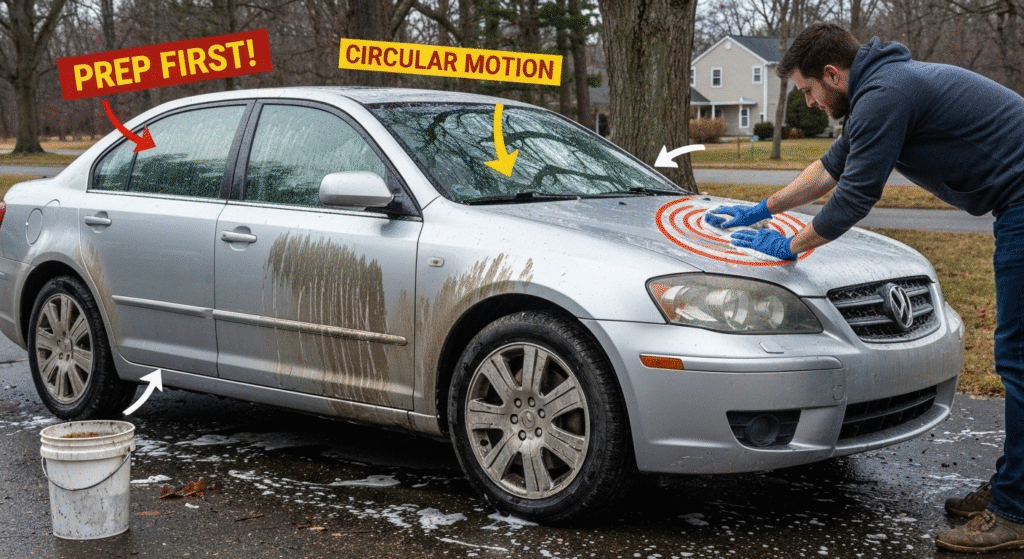
The final major mistake actually combines two related errors: skipping pre-wash preparation and using circular scrubbing motions. Both practices significantly increase scratch risk and reduce cleaning effectiveness.
Pre-Wash Preparation Importance
Jumping straight into washing without preparation means you’re scrubbing heavy dirt and grime directly into your paint. This dirt acts like sandpaper, creating countless micro-scratches that dull your car’s finish.
Pre-rinsing removes loose dirt, leaves, and debris that could otherwise scratch your paint. It also helps you identify areas that need special attention, like tar spots or bird droppings.
Effective Pre-Wash Steps
Start with a thorough rinse to remove loose contaminants. Pay special attention to wheel wells, door jambs, and areas where dirt accumulates.
Use a foam cannon or foam gun if available. The thick foam clings to surfaces and begins breaking down dirt before you make physical contact.
Address specific contaminants before washing. Remove tar with appropriate solvents, treat bird droppings carefully (they’re acidic and can etch paint), and handle tree sap with proper removal products.
The Problem with Circular Motions
Circular scrubbing motions create swirl marks that are visible in bright light. These swirls catch and reflect light differently than undamaged clear coat, creating a dull, hazy appearance.
Instead, use straight-line motions in one direction. If scratches do occur, straight-line scratches are less visible and easier to repair than circular swirls.
Proper Washing Motion Technique
Work in straight lines from front to back or side to side. Maintain consistent pressure light enough to avoid scratching but firm enough to remove dirt effectively.
Lift the mitt or sponge at the end of each pass rather than dragging it back across the surface. This prevents redepositing the dirt you just removed.
| Motion Type | Visibility of Marks | Repair Difficulty | Overall Effect |
|---|---|---|---|
| Circular | High | Difficult | Swirl marks, hazy appearance |
| Random | Medium | Moderate | Uneven scratching pattern |
| Straight Lines | Low | Easy | Minimal visible damage |
Creating a Pre-Wash Routine
Develop a consistent pre-wash routine that you follow every time. This routine should include:
- Visual inspection for damage or special contamination
- Thorough pre-rinse from top to bottom
- Foam application if using foam cannon/gun
- Allowing foam to dwell (3-5 minutes)
- Special treatment for stubborn contaminants
Additional Professional Tips and Best Practices
Beyond avoiding these five major mistakes, several additional practices will help you achieve professional-level results at home.
The Two-Bucket Method
Always use two buckets: one with soapy water and one with clean rinse water. After washing each panel, rinse your mitt in the clean water before reloading with soap. This prevents cross-contamination and reduces scratch risk.
Consider adding grit guards to both buckets. These plastic inserts sit at the bottom and help separate dirt from your wash tools.
Section-by-Section Approach
Wash your car in sections rather than soaping the entire vehicle at once. Complete sections include washing, rinsing, and drying before moving to the next area. This prevents soap from drying on surfaces and ensures thorough cleaning.
Start with the cleanest areas (typically the roof and upper panels) and work toward the dirtiest areas (lower panels and wheels).
Wheel and Tire Care
Clean wheels and tires first or separately from the rest of the car. Brake dust and road grime from wheels can contaminate your wash water and tools.
Use dedicated wheel brushes and cleaners designed for your wheel type. Aluminum, chrome, and painted wheels all have different care requirements.
Frequency and Maintenance
Regular washing prevents dirt buildup that requires aggressive cleaning. Weekly washing in dusty conditions or bi-weekly in normal conditions keeps your car looking its best while minimizing damage risk.
Between washes, use quick detailer sprays to remove light dust and maintain protection. These products are safe for frequent use and help extend time between full washes.
Frequently Asked Questions
How often should I wash my car to avoid damage? Wash your car every 1-2 weeks under normal conditions, or weekly if you drive in dusty or salty environments. More frequent washing with proper techniques is safer than less frequent aggressive cleaning.
Can I wash my car with just water if I don’t have car shampoo? Water alone removes loose dirt but won’t effectively clean oils, road film, or stubborn grime. If you must wash without soap, use distilled water and extra rinse time, but get proper car shampoo as soon as possible.
What’s the best way to remove water spots that have already formed? Fresh water spots often come off with proper car shampoo and gentle scrubbing. Etched spots require specialized water spot removers or professional polishing. Prevention through proper drying is always better than correction.
Should I wax my car after every wash? Waxing after every wash isn’t necessary and can actually build up over time. Apply wax every 2-3 months or when water no longer beads on the surface. Use quick detailer sprays between waxing for maintained protection.
Conclusion
Avoiding these five critical car washing mistakes will save you money, preserve your vehicle’s appearance, and maintain its resale value. Remember that proper car care is about technique, not just effort. Using the right products, tools, and methods makes the difference between a beautiful, well-maintained vehicle and one with irreversible damage.
My five years of professional experience have shown me that most car washing damage is completely preventable. The small investment in proper products and techniques pays dividends in long-term vehicle preservation. Your car is likely one of your most valuable possessions treat it with the care it deserves.
Start implementing these correct techniques with your very next wash. Your car’s paint will thank you, and you’ll notice the difference in both appearance and ease of future cleaning. Take pride in maintaining your vehicle properly it’s a skill that serves you well for years to come.

